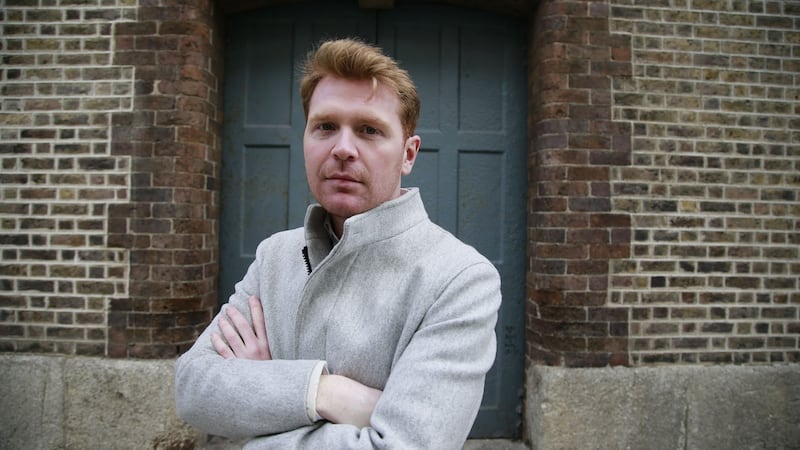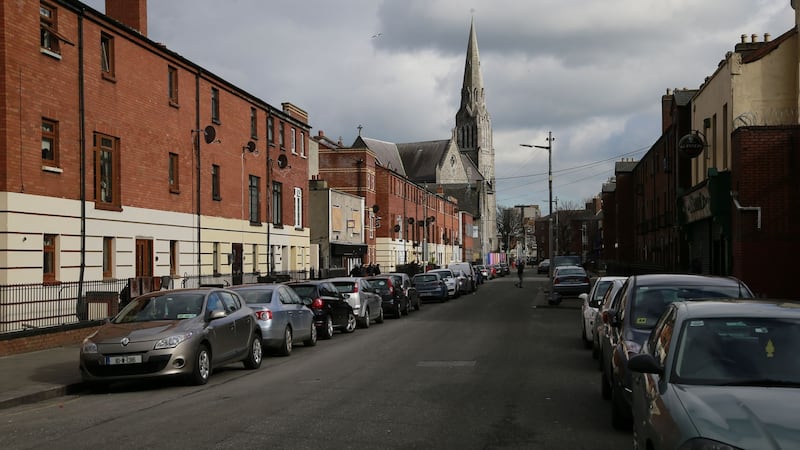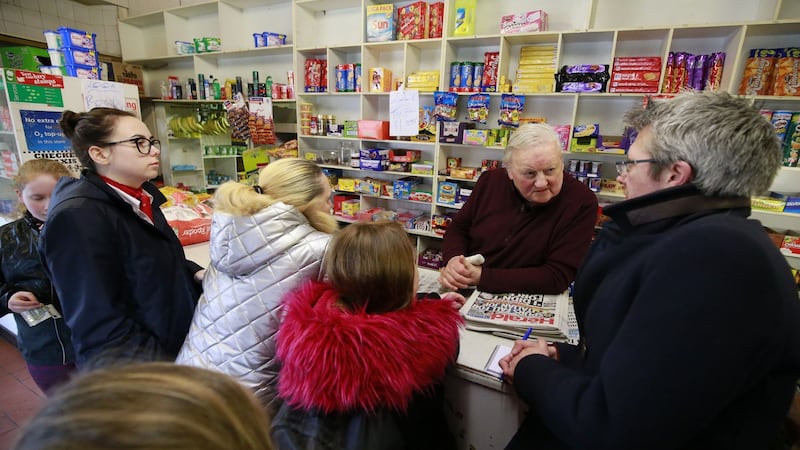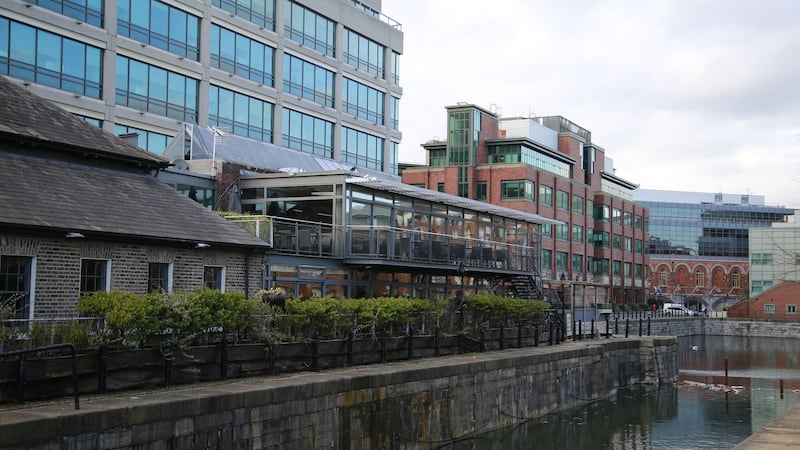Anyone passing by Sheriff Youth Club in Dublin’s north inner city might notice its sparkling new all-weather football pitch.
It is among the first green shoots of an investment strategy in an area long suffering from crippling inequality, but it is the location that really tells the story.
Walk a few metres to the right and you will be met by the shining glass buildings of the International Financial Services Centre (IFSC), its exemplary apartment blocks, bars and restaurants.
The same distance in the opposite direction and you will meet the corner of Sheriff Street Lower where drug dealers shrug off the threat of daylight trading and where violence is a familiar visitor.
At this exact spot in April 2016, in the shadow of investment banks and insurance companies, Martin O’Rourke was shot dead. Mistaken for another man, he was among the first casualties of an expanding Kinahan-Hutch feud.
In fact you don’t have to walk far in any direction to find the site of another execution. It was these gang-related killings that led to the mobilisation of community groups and, shortly afterwards, to a Government commitment to address inner-city problems. It engaged the former head of the Workplace Relations Commission, Kieran Mulvey, to explore the area, its history and possible solutions, culminating in a document known as the “Mulvey Report”.
A year since its publication, and with millions of euro spent in early investment projects, community elders and representatives convey a sense of guarded optimism, an impression this may be the last chance for an area repeatedly left behind.

"Someone was shot here the other night," says Gary Gannon, at the corner of Oriel Street and Sheriff Street. A Social Democrats councillor, Gannon embodies the asymmetrical views of "locals", passionate on the need for change but deeply suspicious of political plans to bring it about.
The 30 year-old is from Summerhill, on the fringe of the investment area. As a child he can remember the wave of drug addiction that swept the inner city. Today he walks through its streets speaking fluently about the problems and the potential, interrupted by passing neighbours and constituents.
“This is a misunderstanding of what is actually happening,” he says of the political response to the poverty and crime-related issues. “What makes us exceptional is the location.”
He is referring to the flare-up in gang violence. A reinvention of the city is long overdue, but Gannon says the same problems exist elsewhere.
“Just because the Taoiseach comes down every so often and throws money around, he thinks he’s going to solve it?”
In February, Leo Varadkar and Minister for Finance Paschal Donohoe visited the area to draw attention to the first anniversary of Mulvey's strategy.
They talked about an investment to date of €7.5 million (with an additional €3.5 million earmarked for 2018). The money has been channelled, in the main, into sports clubs, community and drug projects and development works.
Small area
It is a relatively small area – loosely taking in Sheriff Street to the east, Mountjoy Square to the north and bordered by O’Connell Street to the west and the River Liffey to the south. Educational participation rates are relatively low and in parts, male unemployment has reached double and triple the national average.
Gannon has family members living near to the scenes of shootings. He talks about the nature of an environment that can turn good kids into troubled teenagers.
On a street corner close to a fatal shooting, he explains the crippling local addiction to tablets – benzodiazepines and other prescription sedatives sold on the street. It is not, he points out, driven by the heroin or cocaine imported by criminal gangs associated with the inner city.
“The millions created out of this industry is not created here,” he says.
But importantly for Gannon, there are opportunities and potential in the fabric of the northeast inner city.

For instance, on the corner of the North Strand Road, the long derelict Aldborough House has stood as a symbol of State reluctance to make the best of what is available. “If you want to redevelop the north inner city you take buildings like this and you turn them into art centres,” he says.
Conversely, he points out the former St Joseph's flats on nearby Killarney Street. The dark epicentre of Dublin's slide into heroin addiction in the late 1970s, it has been reshaped into the Killarney Court residential complex, a beacon of the physical regeneration that is possible. Its success is now being replicated in the nearby Mary's Mansions on Seán MacDermott Street Lower.
In preparing his report, Mulvey immersed himself in the area for four months, talking to its residents and “hearing and learning at first hand the challenges they face”. The plan is largely dependent on long-term thinking, not about quick cash injections.
Problems in the neighbourhood can be roughly traced to two areas – drugs and crime, and a community forgotten by an economically improving city, both in terms of employment and development.
False promises
From his research Mulvey describes “a strong and deep sense of being left behind” and “false promises”.
He describes the contrast between the modern IFSC and the neighbouring "concentration of social housing with little or no business activity".
On Seville Place on a busy midweek afternoon, the K&A Stores is thronged with mostly mothers and children, all on first-name terms with its proprietor Gerry Fay. He has lived through the changing eras – from a community of dock workers to the slide into drug problems and related crime in the 1980s – and he is keen to see the Mulvey Report bear fruit.

There has been “30 years of complete negativity” since the development of the IFSC, he says, which swept aside 18 blocks of flats and gave very little back.
“That was done because you couldn’t have the most advantaged section of society living beside the most disadvantaged,” he says. “It was about ethnic cleansing really.”
“It’s a great plan [the Mulvey Report] if it’s implemented. The jury is out. It’s the last plan, there won’t be any more down here because there isn’t the space.
“[Local people] are interested but they are punch drunk from living in exclusion for the last 40 years. We live in the shadow of the IFSC.”
Mulvey was acutely aware of the need for local employment and educational opportunities when launching his report. As the National Economic and Social Council (NESC) said when asked for its summary of the area, "Local jobs doesn't necessarily mean local employment".
Just as with fighting drug addiction and aiding recovery, with improving physical infrastructure, this will take time. The report calls for a government commitment of at least 10 years with a first formal review after three.
Michael Stone is a Dublin businessman appointed by former taoiseach Enda Kenny to head up an implementation committee charged with realising all 54 recommendations in the report. They are broken into four key areas – crime and drugs, physical environment, education and training, and children and youth affairs.
“We know there are major issues down here,” he says. “We have got to try and be positive and that’s what my attitude has been: meet the people and see how we can support them.”
Stone’s appointment has been broadly welcomed; he is described by several people on the ground as capable and determined.
“Quick wins,” he says, can be found in physical street investment, but, like others, he knows the long game is key to revitalising the city.
This is especially true of working with IFSC companies on employment opportunities and Stone is understandably guarded on its progress.
“What I saw was an issue in the IFSC; you have these big fancy buildings with employees who never go into these [inner city] areas. It’s like a different world,” he says.

Last September, 16 of the top 20 IFSC chief executives – the companies have not been identified – came in to the Department of Finance and gave commitments to help young people in the area.
An early-stage mentoring programme was developed to engage with local candidates “in a very detailed way” to “bring them on”. Those companies are at various stages but the candidates selected to take part are in paid office-based roles, with opportunities for career advancement, Stone says.
“It’s not about numbers . . . it’s about making them [the young people] work at how to be a success.”
A separate construction skills programme was established, although there is a lingering suspicion of the value offered by transient jobs on building sites. Still, three of the 50 people who found employment through the programme had been homeless.
After a year, this slow-burn approach to employment seems indicative of a broader philosophy of equipping the area for permanent improvement. Stone envisages “a situation where the young people in the area . . . [can] see a path for themselves. And [that] they are provided with the same opportunities as any other individual in the country,” particularly around education.
“So they see there is [opportunity in] life and how going a different route to what they see every day is a better route for them and for their families.”
Safe
The Mulvey strategy is also about making the area feel safe.
The investment plan includes various measures to tackle crime and drug dealing and central to this is a new Fitzgibbon Street Garda station, the closure of which in 2011, says Stone, “caused local people a lot of anxiety”.
As part of its engagement with the strategy, the Garda North Central Division has installed more CCTVs in the area; a “community support vehicle” is to be deployed; 40 more gardaí will be stationed and there is a renewed focus on community policing.

“The threat of violence is real and constant and the continuation of criminal activity and drug dealing is evident on a daily basis,” Mulvey wrote in his report. “Any regeneration of the community must start at the core which means tackling crime, intimidation and drugs.”
Local TD Maureen O’Sullivan, actively involved in the community response, says tablet dealing is blatant around the city.
“It’s just appalling what goes on in some of the complexes,” she says, and mentions families who “don’t want to let the children out to play”.
But for O’Sullivan, and others, the strategy offers hope. “At this point I think it is the only show in town for the area. We can see something positive coming from it long term.”
Fergus McCabe, a long-time local activist and campaigner, is “positive but weary”. There remains, he believes, a need for more “radical” thinking – a long view that won’t see things peter out. There is an echo of Mulvey here.
“Okay look, the problem with the inner city [is that there] has been some good on local and specific interventions but there hasn’t been a coherent response,” he says. “We are really only beginning the process.”
10 Key Recommendations of Mulvey Report
1) Refurbishment of Fitzgibbon Street Garda station and strengthened Garda presence.
2) Development of new local policing plan, focusing on needs identified by community and residents.
3) Establishment of local business and employers’ network, including multinationals and other firms in the IFSC and Dublin Docklands.
4) Develop enhanced career guidance service for those over the age of 15, targeting summer and transition-year work placements and apprenticeships.
5) “Community Benefits Clause” for developers, to include making planning permission dependent on apprenticeships and internships for residents.
6) Tusla, the child and family agency, to explore development of “specialist hub” for highly vulnerable families.
7) Development of a series of local events to “bring the community together”.
8) Integration of drug treatment, rehabilitation and related health services.
9) “Rebranding” area name in consultation with community to “leave the stigma of the past behind”.
10) “Immediate and urgent” physical improvement works.














